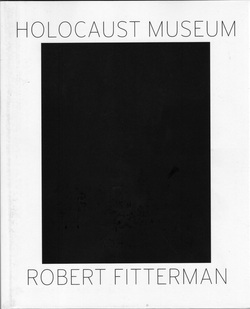
Two: the book nowhere indicates which Holocaust museum is referenced in the title, though details within the text point to the photography collection of the U.S. Holocaust Memorial Museum in Washington, which in its logo highlights the Fitterman's title words “Holocaust” and “Museum”. And if one googles any of this book’s passages, one discovers indeed that the passage is the caption of a photograph in the USHMM collection. That is, as in flarf, all of this book was most likely on-line before it was written or published -- ready to be composed by Ctrl-C / Ctrl-V.
Three: the book is a narrative; one notices this immediately on reaching the table of contents, which begins with
Conceptual poetry has also sometimes been narrative, although not especially focused on story. Kenneth Goldsmith’s The Weather and Traffic were ironically self-cancelling narratives that implied more repetitiveness than change. When I wrote “Sydney’s Wreck” in 2008 I was interested in whether found texts could be found, searched for, in a way that would tell a story without the ‘writer’ having to tell it and without many of the texts themselves being narrative (indeed it seemed they could). The text of Holocaust Museum is made up of the full captions of photographs in a series of sections that, as the contents page indicates, follows the sequence of the events of the Shoah. The USHMM writes on its website, “the temporal parameters of [its] collecting activity extend from the end of World War I to the close of the Jewish displaced persons (DP) camps in the mid-1950s.” Fitterman has probably also found a way to tell a story without telling it, although his text is also readable as further stories – one about both the gaps in “Liberation” (how ‘liberated’ can one be after surviving such captioned events?) and one about various narrativizations of the Shoah, from those of Goebbels and Himmler to those of (one of) the liberators’ museums.
Appropriating the language of the Holocaust, Fitterman’s Holocaust Museum becomes a commentary on that language, beginning with the ‘pretexts’ of German propaganda where the 1930s German caption is preserved within the contemporary USHMM one, continuing through the melodramatic captions of the immediate postwar preserved by the museum as “Original caption reads ...” (121), to the museum’s restrained contemporary ones through which attitude nevertheless sometimes seeps, as in “Supreme Allied Expeditionary Force Commander General Dwight D. Eisenhower poses beneath the Arc de Triomph” (125). One could read and contemplate all of these during a museum visit (as Fitterman has likely managed to do), but in the challengingly distracting context of the photographs above or beside them. Separating the captions from the photographs places an emphasis, and a nakedness, on the former that they could not otherwise easily have. It also creates a ghost image of the missing photo that a reader could be tempted to try to elaborate on the basis of the language clues. The photos are in a sense ‘disappeared,’ along with the Shoah’s six million, leaving behind only 127 pages of terse sentences. The effect is similar to that of Peter Eisenmann’s Berlin “Memorial to the Murdered Jews of Europe” – sparse, reductive, almost repetitive, promising little. The result is an intriguing book that shows much of what conceptual poetry can accomplish.
Conceptual poetry has been somewhat troubled by Goldsmith’s remarks that readers don’t have to read further into most of his books once they have appreciated his methodology for composing them. That’s not the case for Holocaust Museum – even though its referenced events are among the most ‘known’ of human history and its own textual structure quickly apparent, its words offer continuing hermeneutic possibilities.
FD
 RSS Feed
RSS Feed